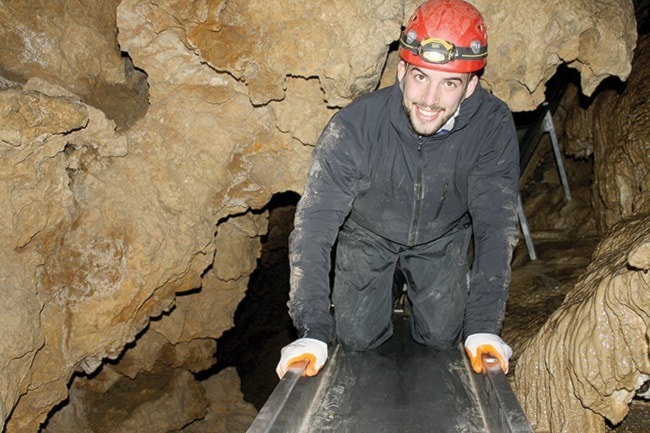Horne Lake Caves may be the first in the world to install a metal slide in one of their 100,000 year old caverns.
"We haven't heard of any other slides in caves yet," Horne Lake park manager Charlene Forrest told The NEWS. "It's something we're looking into."
The four-metre metal slide is one of a few shiny new structural additions the adventure destination welcomed this fall.
Park officials say the structures will increase safety, environmental sustainability and education.
Forrest explains a brand new "ramps and ladders" system was installed in September in Main Cave in an effort to reduce human contact with calcite.
She explains calcite is a crystal formation that takes thousands of years to form but is easily damaged by human contact.
Forrest said the metal structures were custom made in Parksville and put in place by volunteer cavers over a five day period.
They are designed to make caving safer for people by providing a solid, steady base through otherwise steep, rocky terrain while also protecting the precious calcite lining the caves.
Forrest said it's a win-win.
"People are able to focus more on the educational component of our tours if they feel safe," she said. "And the new structures allow for less human contact with the calcite."
The metal structures have limited points of contact within the cave.
Forrest said all together the structures impact less than one square foot of the caves, shielding as much of the calcite as possible.
She said the project was made possible using funds and labour from B.C. Parks, the Canadian Cave Conservancy and the park's cave tour operator, Island Pacific Adventures.
Calcite is a rock-forming mineral that grows naturally within the caves.
In its purest form, lead guide Myles Fullmer said calcite will appear white and reflective.
He said calcite can be a great source of data, providing information about what past climates were like thousands of years ago.
On rare occasions, he said cavers have spotted troglobitic lifeforms living in calcite's rimstone pools.
Not only that, but Fullmer said "it's also really pretty."
He said the fastest growing calcite grows one inch every 100 years and the smallest of formations may be older than a majority of British Columbian forests.
But over the last century, Fullmer said people haven't exactly been kind to the caves.
Before the area was taken over by Horne Lake Caves in 1971, it was completely unregulated.
Fullmer said the now-pristine caves were once filled with broken beer bottles, cigarette butts and litter.
He said volunteers literally took out bags full of garbage when they started cleaning out the caves.
The robust walls made up of ancient rock still have hints of old spray paint — remnants of a bygone era.
And today, park officials are doing everything they can to preserve the caves.
Forrest said the new additions are just a start.
"It's like our way of saying sorry to the caves after a 100 years of not looking after them," she said. "We're making true efforts to protect and apologize to the caves."
Vancouver Island is home to more than 1,200 known caves, but it is estimated that there are closer to 3,000 caves on the Island.
"That means you could actually go where nobody has been before," said Forrest.
Horne Lake Caves Provincial Park is a well known spelunking destination north of Parksville and the attraction is open all year round.
In the winter months, daily departures of the three-hour wet and wild tour and self-guided tours are available. In the summer months, tours range from one and a half to five hours and are offered daily.
For more information visit www.hornelake.com or contact 250-248-7829.
